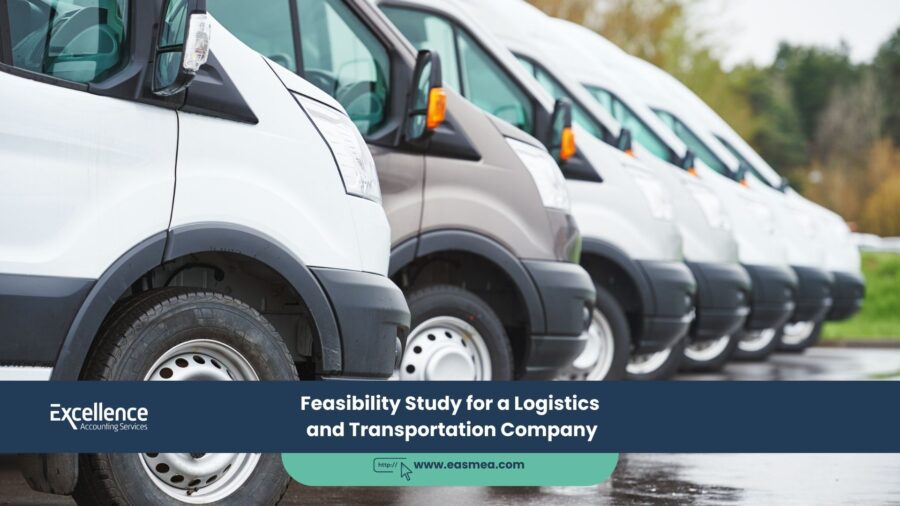A Guide to Feasibility Study for a Logistics and Transportation Companies in the UAE
Positioned at the crossroads of global trade, the UAE is a world-leading hub for logistics and transportation. With state-of-the-art infrastructure like Jebel Ali Port, Al Maktoum International Airport (DWC), and a network of advanced free zones, the opportunities for logistics companies are vast. However, this is also one of the most competitive and capital-intensive sectors to enter. Success is not guaranteed by simply buying a truck; it is forged through meticulous planning, operational excellence, and strategic financial management.
- A Guide to Feasibility Study for a Logistics and Transportation Companies in the UAE
- Why a Feasibility Study is the Engine of a Logistics Venture
- The Core Components of a Logistics Feasibility Study
- Your Strategic Partner in Logistics: Excellence Accounting Services (EAS)
- Frequently Asked Questions (FAQs)
- Planning a Logistics Venture? Map Your Route to Success.
For any entrepreneur or investor looking to launch or expand a logistics and transportation company in the UAE, the **feasibility study** is the most critical first step. This is a comprehensive, data-driven investigation that assesses the viability of the proposed venture from every angle. It scrutinizes the market, analyzes the immense operational complexities, models the challenging financial dynamics, and navigates the intricate regulatory landscape. In a business of tight margins and high asset costs, a feasibility study is the essential tool that separates a profitable enterprise from a failed one.
This guide provides a detailed framework for conducting a feasibility study for a logistics and transportation company in the UAE. We will explore the key components and unique challenges that must be analyzed to build a strong case for investment and a roadmap for success.
Key Takeaways
- It’s a Capital-Intensive Business: A feasibility study is essential to justify the significant upfront investment in assets like vehicles, warehouses, and technology.
- Location is a Strategic Decision: The study must deeply analyze the choice of location (e.g., proximity to ports/airports, Mainland vs. Free Zone like Dubai South) as it impacts cost, market access, and efficiency.
- Operational Plan is the Core: The technical and operational feasibility, including fleet strategy (own vs. lease), warehouse management, and technology (TMS/WMS), is the heart of the study.
- Financials are Driven by Volatile Costs: The financial model must be robust enough to handle volatile costs like fuel and maintenance, and accurately project revenue based on volume and trade lanes.
- Regulatory Compliance is Complex: Navigating licensing from various authorities (Economic Departments, RTA, Customs) is a major hurdle that must be mapped out in the study. A professional feasibility study is critical for this.
Why a Feasibility Study is the Engine of a Logistics Venture
A logistics company is a complex system of moving parts. A failure in one area can bring the entire operation to a halt. A feasibility study is the engineering blueprint for this system, designed to de-risk the significant investment required.
- It Justifies Capital Expenditure: It provides the data-driven case needed to secure financing from banks for major assets like a fleet of trucks or a new warehouse.
- It Optimizes the Operational Model: It forces critical decisions about the business model (e.g., asset-heavy vs. asset-light), service offerings (e.g., 3PL, freight forwarding, last-mile), and technology stack before you are financially committed.
- It Validates the Market Opportunity: It ensures there is real, profitable demand for your services on specific trade lanes or within a particular industry vertical.
- It Creates a Bankable Plan: The study is the foundational document that investors and lenders will scrutinize to assess the risk and potential return of your venture.
In logistics, margins are won or lost in the planning stage. A feasibility study is the most important planning tool you have.
The Core Components of a Logistics Feasibility Study
A comprehensive study for a logistics and transportation company must be a deep and detailed investigation across four key pillars.
1. Market and Commercial Feasibility
This section answers the question: “Is there a profitable market for our services?”
- Service Offering Definition: Clearly defining your niche. Will you focus on Third-Party Logistics (3PL), freight forwarding, warehousing, last-mile delivery, or a combination?
- Target Market and Trade Lane Analysis: Identifying your target customers (e.g., e-commerce, manufacturing, retail) and analyzing the volume, competition, and profitability of specific trade lanes (e.g., Jebel Ali to Riyadh).
- Competitive Landscape: A thorough analysis of existing local and international competitors, their market share, service offerings, and pricing strategies.
- Pricing Model and Revenue Forecasts: Developing a pricing strategy (e.g., per-kilo, per-pallet, per-trip) and building a realistic revenue forecast based on projected volumes and market rates.
2. Operational and Technical Feasibility
This is the logistical heart of the study, detailing how you will deliver the service.
- Fleet Strategy: A critical decision. This involves determining the number and type of vehicles required and deciding on an acquisition strategy: buying (high CAPEX), leasing (higher OPEX), or using a mix of owned and subcontracted vehicles.
- Warehouse and Facility Plan: Analyzing the optimal location (proximity to ports, airports, and customers), size, and layout of any required warehousing facilities. This includes a choice between buying, building, or leasing warehouse space.
- Technology Stack: Planning for the essential software systems, including a Transportation Management System (TMS) for managing routes and fleet, and a Warehouse Management System (WMS) for inventory.
- Human Resources: Planning for the recruitment, training, and licensing of essential staff, particularly drivers, warehouse operators, and customs clearance personnel.
3. Financial Feasibility
This section models the economic viability of the entire operation.
- Capital Expenditure (CAPEX): A detailed budget for all upfront costs, including vehicle acquisition, warehouse deposits or construction, and technology implementation.
- Operational Expenditure (OPEX): Meticulous forecasting of ongoing costs, which are highly variable. This must include fuel, vehicle maintenance, insurance, staff salaries, warehouse rent, and technology subscription fees.
- Funding and Financing: Outlining the plan to finance the CAPEX, including the mix of owner’s equity and potential asset financing or business loans from banks.
- Profitability Analysis: Calculating key logistics metrics like cost-per-kilometer, revenue-per-shipment, and warehouse utilization, leading to a full financial projection (P&L, Balance Sheet, Cash Flow) and investment return calculations (IRR, NPV, Payback Period).
4. Legal and Regulatory Feasibility
Navigating the UAE’s multi-layered regulatory environment is crucial.
- Licensing: Identifying all necessary licenses from the relevant Economic Department (for mainland) or Free Zone Authority.
- Transportation Permits: Ensuring compliance with regulations from the Roads and Transport Authority (RTA) and other federal transport bodies.
- Customs Compliance: If involved in freight forwarding, understanding the requirements for a customs brokerage license and compliance with UAE customs procedures.
- Vehicle and Driver Regulations: Adhering to all rules regarding vehicle specifications, driver visas, and working hours.
Your Strategic Partner in Logistics: Excellence Accounting Services (EAS)
A successful logistics venture is built on a foundation of precise financial planning and operational modeling. EAS provides the expert analysis needed to build a bankable case for your company.
- Specialized Logistics Feasibility Studies: We conduct comprehensive feasibility studies for logistics and transportation ventures, with a deep focus on creating robust financial models that capture the unique cost and revenue drivers of the industry.
- Expert Financial Modeling: Our CFO services team can model complex scenarios, including different fleet acquisition strategies (buy vs. lease) and the impact of volatile costs like fuel.
- Business Plan and Fundraising Support: We develop your feasibility study into a compelling business plan designed to secure the significant asset financing required for a logistics operation.
- Advisory on Structuring: Our business consultancy provides strategic advice on the most effective corporate structure, whether on the Mainland or in a logistics-focused Free Zone like Dubai South.
Frequently Asked Questions (FAQs)
An asset-heavy model means you own your own fleet of trucks and warehouses (high CAPEX). An asset-light model (like a freight forwarder or broker) means you subcontract the transportation and warehousing to third parties (low CAPEX, higher variable costs). The feasibility study must clearly define and analyze the chosen model.
A TMS is a software platform that is the operational heart of a modern logistics company. It helps with route planning and optimization, fleet tracking, carrier management, and freight billing. The cost and implementation of a TMS is a key part of the technical feasibility.
A robust financial model will not use a single fuel price. It will include a sensitivity analysis, showing the impact on profitability at different fuel price points (e.g., a low, medium, and high scenario). This demonstrates to investors that you have considered this major risk.
It depends entirely on your target market. If your primary business is domestic transportation and distribution within the UAE, a Mainland license is essential. If your focus is on international freight forwarding, re-export, and serving the wider region, a Free Zone like Jafza or Dubai South offers significant advantages.
The feasibility study requires active market research. This involves getting preliminary quotes from vehicle dealerships, leasing companies, and commercial real estate agents to build an accurate CAPEX and OPEX budget.
3PL stands for Third-Party Logistics. A 3PL provider offers outsourced logistics services, which can include transportation, warehousing, inventory management, and order fulfillment. Deciding if you will operate as a 3PL is a key strategic choice in the feasibility stage.
If your business will offer customs brokerage, the study must detail the costs and process of obtaining a customs license and hiring licensed customs brokers. The revenue from these services must also be projected.
Poor utilization of assets. An empty truck or an empty warehouse is a significant cash drain. The feasibility study’s revenue model must be based on realistic and achievable asset utilization rates.
Yes, it is essential. A bank will not provide asset financing for a fleet of vehicles without a comprehensive feasibility study that proves your business model can generate sufficient cash flow to make the loan payments.
This is a valuable outcome. The study has saved you from a failed investment. The data should be used to pivot. Can the plan become profitable by focusing on a different niche, using leased vehicles instead of buying, or choosing a more cost-effective location?
Conclusion: Your Roadmap to a Resilient Logistics Business
Launching a logistics and transportation company in the heart of one of the world’s busiest trade hubs is an exciting prospect. However, success in this low-margin, high-volume industry is a game of inches, won through efficiency and planning. A rigorous feasibility study is your essential roadmap, providing the data-driven analysis needed to navigate the challenges, secure funding, and build a resilient, profitable, and scalable logistics operation.
Planning a Logistics Venture? Map Your Route to Success.
Partner with Excellence Accounting Services to conduct a comprehensive, bank-ready feasibility study for your UAE logistics and transportation company.



